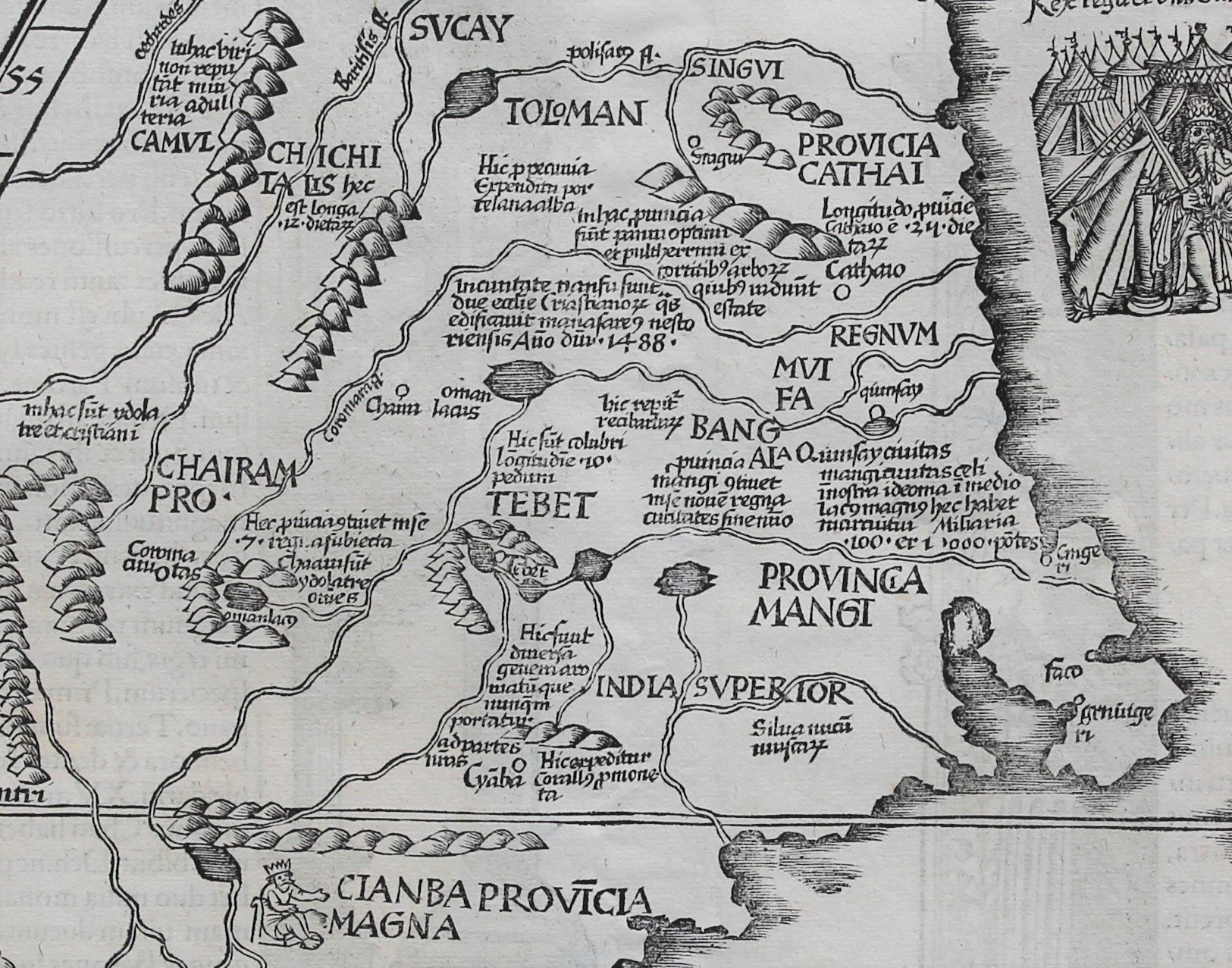China, Tartary and Japan
The first modern map of China printed in Europe
Detail
Date of first edition: 1522 (with banderole)
Date of this edition: 1535 (verso: Ta. Superioris Indiae et Tartariae Maioris)
Dimensions (not including margins): 29 x 45 cm
Dimensions (including margins): 39,3 x 54,3 cm
Condition: excellent. Sharp wood engraving printed on strong paper. Centre fold as published. ide margins.
Condition rating: A+
Verso: text in Latin
Map reference: Karrow 28/46 (for 1522 map); Walter, Japan, A Cartographic Vision, p. 185, No.3
From: Geographia of Claudius Ptolemy, first published in Strasbourg by Johann(es) Grüninger in 1522. This publication also in Strasbourg, 1535.
In stock
Lorenz Fries’ China and Japan: back in time and space …
A very important map of China, the first ‘modern’ printed map of the area, covering China, Tibet, Tartary and Japan, Fries published a slightly smaller format edition of Ptolemy’s ‘Geographia’ (by Martin Waldseemüller). Unlike most of the maps in this work it was not a reduction of a map from the larger Waldseemüller editions of 1513-1520, but a completely new map. It had been prepared for a new ‘Chronica mundi’ being written by Waldseemüller which was abandoned after his death.
Waldseemüller had expanded the Ptolemaic map by adding information on Tartary and Japan gleaned from the accounts of Marco Polo (1254-1324). This map is, indeed, the first to illustrate Marco Polo’s writings in cartographic form on a separate map dedicated exclusively to the Far East region. While there is no mention of the name China, many of the names used by Marco Polo are shown on the map. The Port of Quinzay [Hangzhou] is identified on the Eastern coast and Zinpangri [Japan] appears prominently across the sea from China. Curiously no mention is given to Polo’s Zaiton.
The great Kubai Khan (1215-124) sits in a tented campment, holding two swords (in the upper right of the image). Marco Polo met Kublai Khan in 1269. Polo’s division between Cathay in the Northern regions of China and Mangi or Manzi in the South is clearly illustrated.
Japan is a large island called Zipangri, a name derived from the Chinese ‘Land of the Rising Sun’, which Polo learned about from the Chinese. The first recorded European visit to Japan was not until the landing of the Portuguese Alvarado in Okinawa, 1542.
First issued in 1522, this second edition has the title on the reverse, with a descriptive text in Latin, with woodcut columns and an astronomical diagram. The map is depicted on a trapezoidal projection.
Lorenz Fries
Lorenz (Laurent) Fries was born in Alsace in about 1490. He studied medicine, apparently spending time at the universities of Pavia, Piacenza, Montpellier and Vienna. After completing his education, Fries worked as a physician in several places, before settling in Strasburg, in about 1519. While in Strasburg, Fries met the Strasburg printer and publisher, Johann Grüninger, an associate of the St. Die group of scholars formed by, among others, Walter Lud, Martin Ringmann and Martin Waldseemüller.
From 1520 to 1525, Fries worked with Gruninger as a cartographic editor, exploiting the corpus of material that Waldseemüller had created. Fries’ first venture into mapmaking was in 1520, when he executed a reduction of Martin Waldseemüller’s wall-map of the World, published in 1507.
Fries also prepared three new maps for the Geographia: maps of Southeast Asia and the East Indies, China and the world. The cartographic details for these three modern maps derives from Waldseemüller’s world map of 1507, which Fries had viewed and copied prior to 1520, utilizing this information for the preparation of the 1520 Apian World map identified above. The 1522 edition of Fries’ work is very rare, suggesting that the work was not commercially successful. In 1525, an improved edition was issued, with a re-edit of the text by Wilibald Pirkheimer, from the notes of Johannes Regiomontanus. After Grüninger’s death in 1531, the business was continued by his son Christoph, who seems to have sold the materials for the Ptolemy to two Lyon publishers, the brothers Melchior and Gaspar Trechsel, who published a joint edition in 1535, before Gaspar Trechsel published an edition in his own right in 1541.








